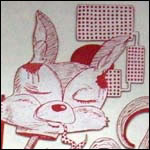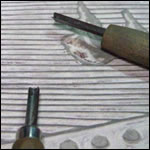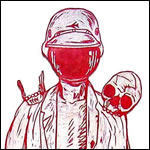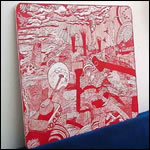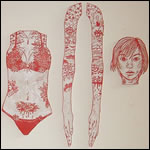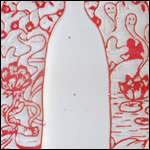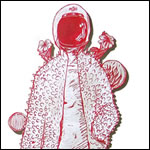Kenichi Yokono Artist Interview
Award-winning Japanese artist Kenichi Yokono has been getting an increasing amount of attention outside of his home country recently. His artwork stands out both because of his chosen media -- large, boldly painted woodcuts -- and because the compositions themselves often touch on themes that remind the viewer of Japanese manga, horror movies, and monsters. The horror element is no accident, either - the author himself has called some of his work "The Horror of Every Day Life".
Yokono-san graduated from art college in Japan in 1997 and has been on an upward trajectory ever since. He was invited to participate in several of the early Tokyo art fairs organized by Japanese art superstar Takashi Murakami. Yokono has also won both the Eriko Osaka Prize and the Tom Tom Eccels Prize, and his works have appeared in numerous solo and group shows in Japan. Earlier this year, he participated in the Pulse Art Fair in New York. Currently, Yokono's work is part a group show at the Mark Moore Gallery in Los Angeles.
With all of the things he has going on, Yokono still found the time to talk to Horror.com about his work, horror films, and the Japanese contemporary art scene. Enjoy the interview, and don't forget to check out his official website for the latest news on his work and upcoming shows.
Horror.com: At least one of your exhibitions was called "The Horror of Daily Life". What does that mean? How does it relate to your work and to life in general?
Yokono: It means a comparison between daily life, which stands for normalcy, and horror, which is abnormality. What I attempted to express is not insanity within daily life, but something visually beautiful within hideous, frightening things. This applies to all my work in general, and it is the reason why I often use red – a strong color that is associated with blood.
Horror.com: A lot of contemporary Japanese art today seems to have a 'cute' factor. In fact, "cuteness" (kawaii) seems to have a special place in Japanese society - with Hello Kitty, Anpanman, Doraemon, and all of the related cute characters. Your artwork is darker - sometimes darkly comic, but certainly not 'cute'. Is that a reaction against the cuteness all around you in society or is there some other inspiration?
Yokono: The cuteness definitely has established a certain status within Japanese culture. I am not sure whether my artistic expression is a reaction against the cuteness, but my work is certainly the opposite of simplified expressions of those cutesy characters (like Hello Kitty, etc), since I pursue complex lines and shapes within details.
At the same time, darkness, as found in my work, has also been a staple factor in Japanese culture. Ukiyoe woodblock prints -- which are said to be the mother of Japanese pop culture and functioned back then as today’s comics do -- contain both cute and dark characteristics. So you can say that my work is uniquely Japanese in that way.
Horror.com: You make woodblock art. Why do you work in wood, and what influenced you to do so?
Yokono: Honestly, I originally took up woodblock printing because it was easy to do so. I had some woodblock carving knives I used in elementary school, and woodblocks were readily available for purchase at a nearby store. But printing turned out to be a challenge! To place ink on bigger pieces and print them, I needed assistants and a large work space. Gradually, that led me to regard woodblocks themselves as finished products.
What initially inspired me to think about starting woodblock printing is a flier for a live concert. I don’t know who the artist was, but that was when I saw the possibilities of woodblock printing.
Horror.com: Can you talk a little about the process involved in creating one of your woodblock pieces?
Yokono: First, I make a sketch of my ideas on a small piece of paper, like on a memo pad, so that the pencil lines and shapes retain a certain energy. I give shape to my image quickly, without spending too much time. Sometimes, I enlarge this sketch using a copier or a projector, and transfer the image to the woodblock. Then I take a look at the wood as a whole, add details, and start cutting. When the cutting is completed, the whole block is spray-painted white, and then I add red paint using a roller to finish the piece.
Horror.com: You've been invited to participate at Takashi Murakami's Geisai art fair in Tokyo several times over the last few years. Tell us about your experiences at Geisai.
Yokono: At Geisai, Eriko Osaka of the Mito Arts Foundation and Tom Eccles of the NY Public Art Fund chose my work for their "personal pick" awards. Until then, few competitions accepted my kind of artwork, and Geisai was a good opportunity. Because I don’t live in Tokyo, it also gave me a chance to meet many other modern artists, and was stimulating.
Horror.com: To an outsider, the Japanese contemporary art scene seems to be thriving. There are numerous galleries, several large museums dedicated to contemporary art, and a growing number of internationally popular young Japanese artists. Also, many people attend the big Tokyo shows and fairs like GEISAI and Design Festa. Do you find that the contemporary art scene in Japan is supportive of young artists?
Yokono: In Japan, the mainstream organizations are still oriented to traditional forms of expression like oil painting and Japanese painting, which is what the market prefers. A modern art museum was opened in my region 2 years ago, but 1/3 of its space constantly has pictures of mountains, rivers and nudes. Financially, Geisai has run a deficit every year, and the next year may be the last time we have Geisai.
However, l still feel that in the last few years, exhibitions of internationally successful artists such as Takashi Murakami and Yoshitomo Nara have triggered growing interests for modern art in Japan.
Horror.com: Do you have any favorite contemporary artists -- Japanese or international -- who you think are doing exceptional work right now?
Yokono: I have many favorites. My favorite medium is not limited to two dimensional expressions -- I like them all! For example, I find sculptures of Ushio Shinohara, and the elaborately detailed expressions of Fred Tomaselli interesting.
However, just like any artist who frequently exhibits at international fairs, I am always inspired by artists I meet in NY, their work, and work of my artist friends.
Horror.com: I read that -- without the backing of a gallery -- you were one of only a few artists with their own booth at the Pulse Fair in New York earlier this year. What was it like to show your work at Pulse? How was the response from other artists, collectors, and galleries?
Yokono: I felt extremely lucky and honored to have an opportunity to exhibit at an art fair such as that one. When I participated in Artist-in-Residence in North Carolina for the first time, a manager from Pulse visited the exhibit and liked my work, and fortunately I was invited to show at Pulse. It was my first experience of participating in such a fair, as well as meeting so many collectors and gallery owners, so everything seemed new and fresh to me.
Horror.com: Some of the pieces from the upcoming group show in Los Angeles have a little bit of a "Texas Chainsaw Massacre" feel to them. A few of the pieces seem like they could be partially inspired by 1970s horror movies. Did you watch any horror movies while growing up? If so, do you have any favorite horror movies?
Yokono: Yes, I watched horror movies often. I especially like zombie movies. My recent work has dozens of zombie arms drawn to form a circle.
Horror.com: Your current show is the "Ultrasonic International 1" group show at the Mark Moore Gallery in Santa Monica. After that, do you have any future shows planned where people can see your work?
Yokono: My work will be shown at the Miami Art Fair in December, and in March 2007 at the NY fair, as a part of the Mark Moore Gallery collection. I also have plans to participate in group exhibitions in Milan in October 2006 and in Vienna in January 2007.
Horror.com: Thank you for taking the time to answer our questions.
Related Links:
Official Artist Site: Kenichi Yokono's Official Website
Mark Moore Gallery: Gallery Website
Geisai Art Fair: Geisai Website
Other Links: 21st Century Museum of Contemporary Art, Mito Arts Foundation, NY Public Art Fund, Pulse Art Fair, Kuniyoshi Wood Block Print With Horror Elements..
Note: This interview was originally conducted in Japanese and then translated into English.




